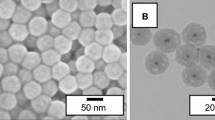Abstract
The bioeffects of silica nanoparticles (SiNP), phosphorylate-terminated nanoparticles (PO4NP) and amino-terminated nanoparticles (NH2NP) on HaCaT cell line have been studied in this paper. The effects of the three kinds of functionalized silica nanoparticles on adherence, proliferation and cycle of HaCaT cells have been investigated. And the cellular uptake of the three kinds of functionalized silica nanoparticles by HaCaT cells has also been examined. Results indicated that the bioeffects of the three kinds of functionalized nanoparticles on HaCaT cells were concentration-dependent. And the three kinds of functionalized nanoparticles all exhibited well biocompatibility if the concentration was below 0.2 μg/μL. While the cytotoxicities of the three kinds of functionalized nanoparticles on HaCaT cells would increase with the increasing of nanoparticles concentration, and the following order was observed: NH2NP > SiNP > PO4NP. In addition, the quantity and rapidity of cellular uptake of nanoparticles by HaCaT cells were diverse due to the different functional groups. Under the same conditions, NH2NP was most and fast internalized by HaCaT cells, followed by SiNP, and PO4NP was the least and slowest. These results provided theoretical foundation for the safe application and further modification of silica nanoparticles, which could broaden the application of silica nanoparticles in biomedicine.
Similar content being viewed by others
References
Akerman M E, Chan W C W, Laakkonen P, et al. Nanocrystal targeting in vivo. PNAS, 2002, 99: 12617–12621
Santra S, Zhang P, Wang K M, et al. Conjugation of biomolecules with luminophore-doped silica nanoparticles for photostable biomarkers. Anal Chem, 2001, 73: 4988–4993
He X X, Wang K M, Tan W H, et al. Bioconjugated nanoparticles for DNA protection from cleavage. J Am Chem Soc, 2003, 125: 7168–7169
Service R F. Nanomaterials show signs of toxicity. Science, 2003, 300(11): 243
Zhang W X. Environmental technologies at the nanoscale. Environ Sci Technol, 2003, 37(5): 103–108
Kelly K L. Nanotechnology grows up. Science, 2004, 304: 1732–1734
Jia G, Wang H F, Yan L, et al. Cytotoxicity of carbon nanomaterials: single-wall nanotube, multi-wall nanotube, and fullerene. Environ Sci Technol, 2005, 39:1378–1383
Ajay K G, Mona G. Cytotoxicity suppression and cellular uptake enhancement of surface modified magnetic nanoparticles. Biomaterials, 2005, 26: 1565–1573
Afaq F, Abidi P, Matin R, et al. Cytotoxicity, pro-oxidant effects and antioxidant depletion in rat lung alveolar macrophages exposed to ultrafine titanium dioxide. J Appl Toxicol, 1998, 18: 307–312
Scholer N, Hahn H, Muller R H, et al. Effect of lipid matrix and size of solid lipid nanoparticles (SLN) on the viability and cytokine production of macrophages. Int J Pharm, 2002, 231: 167–176
Ziady A G, Gedeon C R, Muhammad O, et al. Minimal toxicity of stabilized compacted DNA nanoparticles in the murine lung. Mol Ther, 2003, 8(6): 948–956
Akiyoshi H, Kouki F, Taisuke O, et al. Physicochemical properties and cellular toxicity of nanocrystal quantum dots depend on their surface modification. Nano Lett, 2004, 4(11): 2163–2169
Oberdörster G, Ferin J, Gelein R, et al. Role of the alveolar macrophage in lung injury: studies with ultrafine particles. Environ Health Perspec, 1992, 97: 193–199
Deng Y, Xu H B, Huang K X, et al. Size effects of realgar particles on apoptosis in a Human Umbilical Vein Endothelial Cell line: ECV-304. Pharmacol Res, 2001, 44(6): 513–518
Sayes C M, John D F, Guo W, et al. The differential cytotoxicity of water-soluble fullerenes. Nano Lett, 2004, 4(10): 1881–1887
Catherine M G, Catherine D M, Tuna Y, et al. Toxicity of gold nanoparticles functionalized with cationic and anionic side chains. Bioconjug Chem, 2004, 15: 897–900
He X X, Wang K M, Tan W H, et al. Concentration of trace amounts oligonucleotide using super-paramagnetic DNA nano-enricher. Chem J Chinese U, 2003, 24(1): 40–42
Bruce I J, Sen T. Surface modification of magnetic nanoparticles with alkoxysilanes and their application in magnetic bioseparations. Langmuir, 2005, 21: 7029–7035
He X X, Wang K M, Tan W H, et al. A novel fluorescent label based on biological fluorescent nanoparticles and its application in cell recognition. Chin Sci Bull, 2001, 46(16): 1353–1356
Wang L, Yang C Y, Tan W H. Dual-luminophore-doped silica nanoparticles for multiplexed signaling. Nano Lett, 2005, 5(1): 37–43
Zhao X J, Tapec-Dytioco R, Tan W H. Ultrasensitive DNA detection using highly fluorescent bioconjugated nanoparticles. J Am Chem Soc, 2003, 125: 11474–11475
He X X, Wang K M, Tan W H, et al. A novel gene carrier based on SiO2 amino nanoparticles. Chin Sci Bull, 2002, 47(18): 1365–1369
Yang H H, Zhang S Q, Chen X L, et al. Magnetite containing spherical silica nanoparticles for biocatalysis and bioseparations. Anal Chem, 2004, 76(5): 1316–1321
Li D, He X X, Wang K M, et al. Cytotoxicity detection of silica nanoparticles. Human University Bull, 2002, 29(6): 1–6
Zhu S G, Gan K, Li Z, et al. Polylisine—the biocompatibility study of silica nanoparticles. Cancer, 2003, 22(10): 1114–1117
Inbaraj J J, Chignell C F. Cytotoxic action of juglone and plumbagin: a mechanistic study using HaCaT keratinocytes. Chem Res Toxicol, 2004, 17: 55–62
Author information
Authors and Affiliations
Corresponding author
About this article
Cite this article
He, X., Liu, F., Wang, K. et al. Bioeffects of different functionalized silica nanoparticles on HaCaT cell line. CHINESE SCI BULL 51, 1939–1946 (2006). https://doi.org/10.1007/s11434-006-2077-1
Received:
Accepted:
Issue Date:
DOI: https://doi.org/10.1007/s11434-006-2077-1




